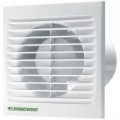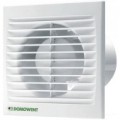-
Pull cord switch. Pull cord switches, as the name suggests, operate using a cord pulling which turns the fan on/off. Such a switch is especially convenient in cases where the fan itself is installed high and it is difficult to reach its housing. In addition, it has another advantage common to all built-in switches - ease of connection: you do not have to mount a separate switch in the wall (or link the ventilation to the lighting), just connect the power to the fan. These models are recommended primarily in cases where the extractor fan is planned to be turned on quite often, but for a short time - for example, for installation in an ordinary home kitchen.
-
Non-return valve / shutters. The presence of a valve in the design of the fan or a system of automatic shutters. These types of equipment are combined into one item because they have the same purpose: to prevent the movement of air in the opposite direction — into the room — when the extractor fan is turned off. It allows, for example, to avoid unpleasant odours from entering the kitchen from the bathroom located behind the wall, using the same ventilation duct. The non-return valve is a characteristic "petal" that closes when air moves in the "wrong" direction. Automatic shutters open when the fan is turned on and close when it is turned off; they are considered a more advanced option, however, and cost accordingly.
-
Built-in clock. The clock in such models is installed directly on the extractor fan cover. Thus, the unit also plays the role of an ordinary wall clock. Such devices are designed for situations where the air duct opening is in a prominent place and it is undesirable to install a conventional cover there from a design point of view — they not only allow you to find out the time but also look quite aesthetically pleasing. Also, with the proper degree of moisture protection (see below), clock fans can be useful for the bathroom — especially for those who tend to stay in the shower or bath for a long time. But in other cases, it is easier to buy the clock and the fan separately.
-
Timer. The presence of a shutdown timer in the design of the fan. This feature, as a rule, is implemented as follows: after the shutdown command, the fan continues to work for some time and turns off only after the time for which the timer is set has passed (most often, the adjustment range is from 2 to 30 minutes). Thanks to this, you can safely leave the room that needs to be ventilated (for example, from the bathroom after a shower): you do not have to keep track of the time and return to the fan to turn it off, this will be done automatically.
-
Delayed start. The way this function works is described in the name itself: when it is used, the fan starts working some time after the switch-on command (usually this time is short — up to 2 minutes). The meaning of the delay is that the fan does not start immediately, but when the need for it becomes relevant. An example is a fan installed in the bathroom and tied to a light switch: in the first two minutes after entering the bathroom, the humidity is unlikely to rise much, and there is simply no need to start the hood, but with a longer stay it may be needed.
-
Humidity sensor. The presence of a humidity sensor in the design of the fan. This function is useful primarily in cases where the fan is used to remove excess moisture from the air — for example, in bathrooms. The sensor can provide both automatic switching on of the device with a significant increase in the amount of moisture in the air, and switching it off when the humidity decreases. In the latter case, it works similarly to the timer described above. However, it is more efficient, since the shutdown does not depend on time, but on reaching the desired conditions in the room. Specific features of this function in different models may vary.
-
Motion sensor. The presence of a motion sensor in the design of the fan. Such a sensor provides additional automation of on/off: it automatically starts the fan when people appear in the room. The shutdown can be carried out both by a combination of a sensor and a timer — with some delay after the movement in the room has stopped — and by a manual command from the user. The specifics of how this function works in different models may be different.
-
Light sensor. The light sensor provides additional automation for turning on/off the extractor fan. In particular, it automatically starts ventilation when the light is turned on in the room. Switching off can be carried out by a combination of a sensor and a timer — after the light is turned off, the fan continues to work for some time and turns off only after the time period for which the timer is set has passed.
-
Temperature sensor. This feature can be used in two main ways. The first one is similar to how the humidity sensor described above works: the device monitors the temperature in the room and, if necessary, turns on the fan, and turns it off when the need disappears. The second option is to work as a security system: if the supply air temperature is too low or too high, the sensor turns off the fan, protecting the device from damage due to abnormal operation. This option is especially relevant for models with air supply capabilities (see "Type").
-
Backlight. The presence in the design of the fan LED-backlight, activated in conjunction with the inclusion of ventilation. The lighting system allows you to gently designate the product, and emphasize the colour of the cover and the texture of the material. In addition, the backlight looks stylish in low light or off.
The above list is not exhaustive, and other additional features may be provided in the design.
The level of protection of the fan housing (more precisely, sensitive parts located in the housing) from dust and moisture, measured by the IP standard. This standard assumes marking in the form of two numbers after the letters IP — for example, IP54. In this case, the first digit describes the level of protection against dust and other objects, and the second — from moisture.
In terms of resistance to the penetration of foreign objects in fans, the following values \u200b\u200bcan be found:
2 — protection against objects larger than 12.5 mm (enough to protect against adult fingers);
3 — from objects larger than 2.5 mm;
4 — from objects more than 1 mm (not every wire can get inside);
5 — full protection against objects; a small amount of dust may have entered the unit without any noticeable effect on performance.
In terms of water protection, options can be as follows:
4 — resistance to water splashes from any direction;
5 — resistance to water jets from any direction;
7 — the ability to endure short-term immersion in water to a depth of 1 m without consequences.
There are also higher rates of water protection. However, it does not make sense to provide them to fans. The mentioned "4" and "5" are quite sufficient for installation in bathrooms, showers and most other places where there is
...a possibility of moisture getting on the units, higher levels of protection complicate and increase the cost of the design, and there is very little practical need for them.
In some models, instead of one digit (most often the first one), there may be the letter X. This does not mean the absence of appropriate protection — it most often exists, and sometimes its degree can be quite high; we are only talking about the fact that official testing according to the IP standard was not carried out. For example, a fan marked IPX4 can be closed even from a thin wire, but if it passed official tests only for moisture resistance, the manufacturer has the right to indicate only one digit.
It is also worth noting that the complete absence of IP marking does not mean a lack of protection. However, if resistance to dust and moisture is crucial for you, you should still choose among models where this feature is officially claimed by the manufacturer.Mounting depth of the fan with a standard installation method.
This parameter describes how deep into the duct the unit (or its parts in the case of surface-mounted models, see "Type") is placed during installation. Knowing the mounting depth, it is possible to assess the suitability of the selected model for a particular installation location: a flat section at the very beginning of the duct must be no less than the installation depth of the selected fan.
The smallest value of this parameter is typical for some overhead models of fans: in them, the main part of the structure is outside, and usually, only 2-3 centimetres are required for installation. And most of all, hidden units require space (see "Type").

